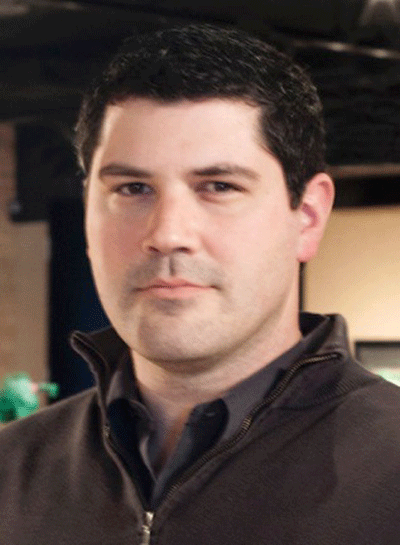If you’ve taken a stroll through Artlink or Crestwood galleries lately, you might have noticed a few surprising pieces hanging on the walls. Justin Johnson, a local favorite, is changing gears as he explores a brand new style, purpose and technique. Most of us are familiar with Johnson’s previous body of work: warm toned backgrounds layered with succinct, sometimes figurative drawings topped by a thin, translucent veil of gold overlay. His current pieces are void of color, minimalist abstracts representing transomed and transeptal features of architecture, most frequently derived from medieval references.
“This is a distinct departure from what I normally do,” says Johnson. “This is something I’d been planning out in my mind for about a year and a half.”
Johnson’s new approach involves the use of velum, a translucent paper that allows him to simultaneously use both the back and front of the substrate. Similar to his earlier work, this technique requires the careful manipulation of layers, each one placed after a great deal of contemplation, until the artist achieves a sense of completion.
“If you distill both bodies of work you still see very similar aspects in terms of composition,” says Johnson. “Doing both an under-drawing and over-drawing on velum doubles the value of the tones in terms of what’s positive and negative.”
Black, white and grey tones pull Johnson away from his previous body of work, but those tones allow him to focus on composition and the process of building each piece. When faced with a blank piece of velum, Johnson first lays down a series of loose lines with pencil. He studies these lines, searching for beginnings of satisfying compositions.
“I work on a large sheet in several different areas or grids,” he explains. “I begin to see compositions develop and trim those areas off. On a sheet I may have four to six compositions going at the same time, and then I pull those pieces out and rework them into a finished sense … I work until if I put another line down I will dismantle it.”
In his work Johnson tries to extract the fundamental elements of ancient architecture. He tries to capture the spiritual experience felt when entering a majestic, ancient cathedral.
“I like to take a contemporary perspective on them,” he says. “It’s a matter of working with distillation of line and shape to create these compositions.”
As Johnson’s pieces progress, he tries not to take lines away. Unwanted marks are not erased but rather incorporated into the design, which is often accomplished by applying layers of a dominant medium.
“With working on both sides of the velum I can kind of erase lines that I don’t want to use by overlapping with ink and Wite-Out,” he explains.
Johnson is a contemplative artist who saves the unused fragments of the original substrate and studies them to learn about himself; he learns about how he works as an artist, especially how he develops composition.
Careful observers can learn about Johnson’s thought process if they look for the similarities in past bodies of work that led him to his current work. As he was working on his most recognizable pieces, the figurative, warm-toned compositions, he began to pay more attention to the translucent quality of the gold overlay than the primary subject of each piece. He was attracted to the intuitive nature of the medium.
Working with the gold was a bit uncontrollable. According to Johnson, it sometimes wanted to do it’s own thing which forced him to follow the path of the paint and use spontaneity to his advantage. His inquisitive nature led Johnson to think about new options. As he finished his work with gold overlay, he found himself fantasizing about velum, charcoal, pencil and Wite-Out. He decided to leave color behind.
Once he started producing these new pieces, Johnson felt reinvigorated and steamed forward.
“I love the minimal aspects of this,” he says. “I probably won’t go back to color until I feel like I’ve conquered the aspects of black and white … there is a meditative quality about them without color.”
By removing color from the equation, Johnson is able to create simplistic landscapes and architectural structures that emit a serene tone that pulls the viewer in, tempting one to look past the page and imagine what might exist beyond his picture plane.
Johnson’s passion for the design of structure is deeply seated. With a background in drafting and architecture, his mind is predisposed to concise lines and angles.
“My work has always been a bit rigid,” he says. “If I go too far in another direction, it will feel contrived.”
The influences of two area artists, Rick Cartwright and Maurice Papier, also steer Johnson’s approach to making art. Johnson was introduced to these artists through his study as an undergraduate at the University of Saint Francis where he went on to fulfill his master’s degree. Johnson’s relationship with the university continues; he has spent the past 12 years serving as gallery director.
“My work as a director has allowed me to study a broad range of artists,” he says. Being exposed to a constant stream of art – ranging from smoke paintings and contemporary installations to traditional oil paintings – Johnson enjoys an ongoing influx of new material that accumulates in his mind, waiting to be extracted and expressed onto canvas.
Art enthusiasts in town are becoming familiar with Johnson’s new body of work. It has been displayed at the faculty expo at the University of Saint Francis, Crestwood Gallery and Artlink. He hopes to soon accumulate enough pieces to support a solo show.
You can catch a glimpse of his work at Crestwood Gallery during its year-end show, Greatest Hits. A closing party will be held Saturday, January 17 from 3-6 p.m. The show closes officially on January 31.
 Submit Your Event
Submit Your Event

